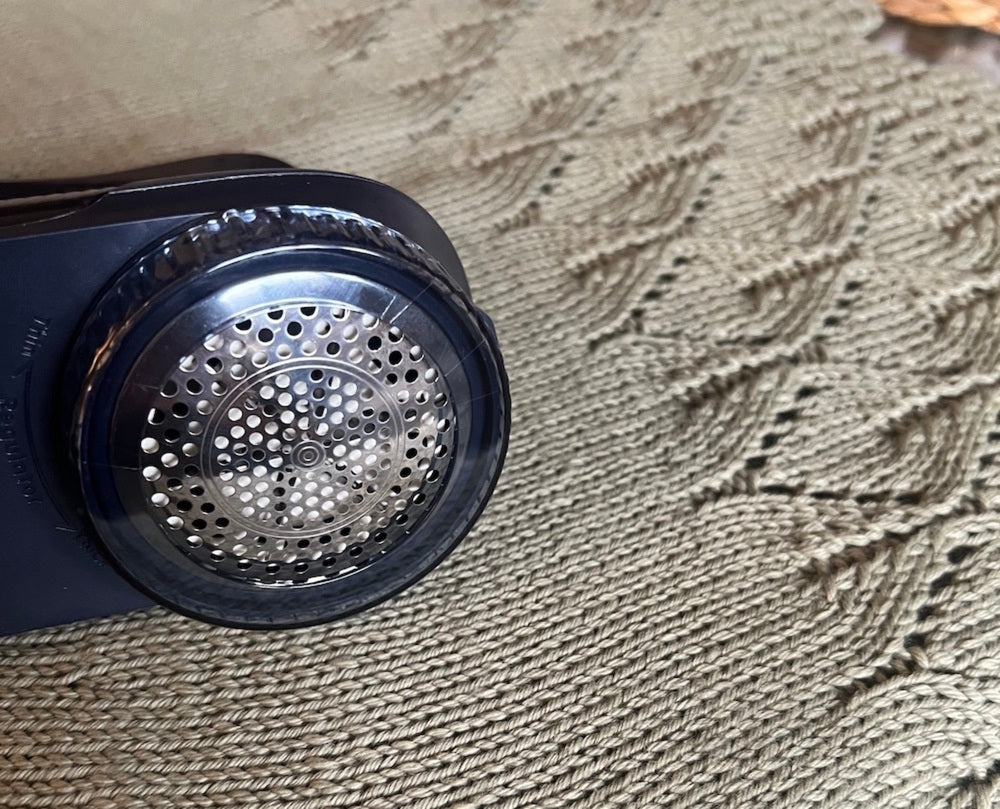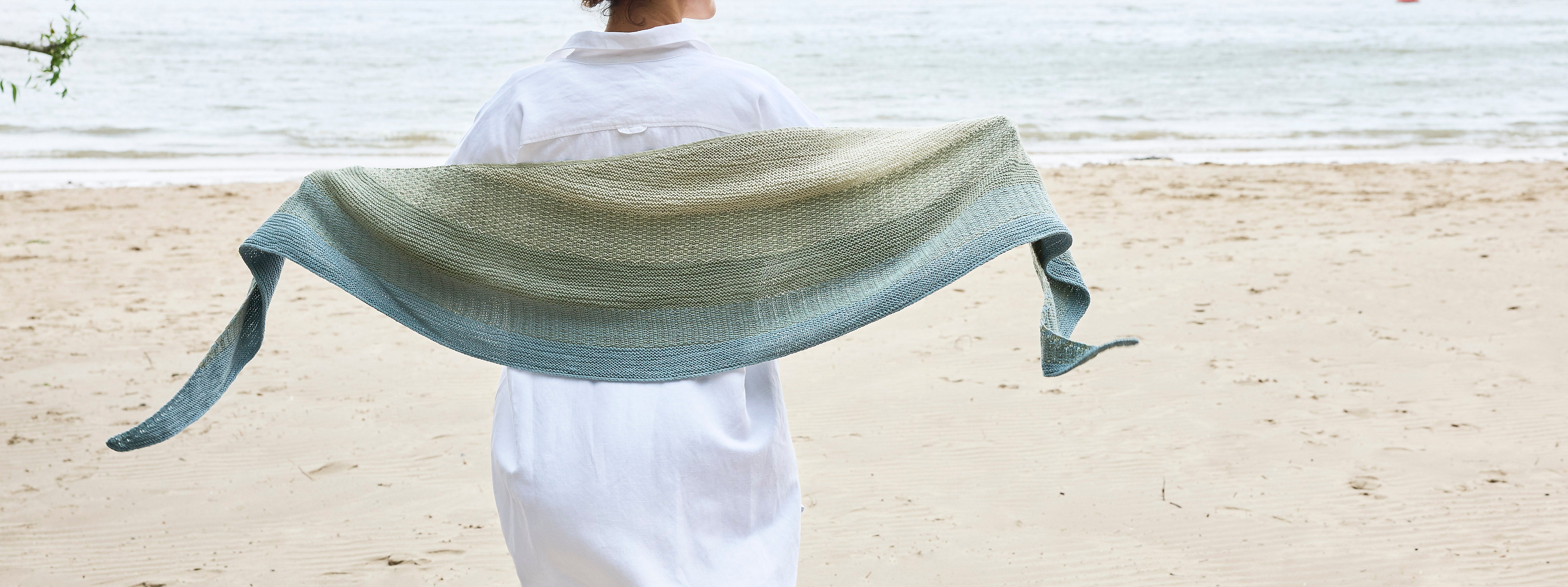Was tun bei Pilling?
Wir alle kennen sie: die kleinen Knötchen und Fusseln, die sich früher oder später in unterschiedlicher Stärke auf Kleidungsstücken entdecken lassen. Besonders bei Gestricktem ist diese Knötchenbildung, das sogenannte Pilling, leider gang und gäbe.
Was ist Pilling genau und wie entsteht es?
An der Oberfläche des Gewebes gibt es immer etwas lockerere, lose Fasern, besonders natürlich bei kuscheliger, weicher Wolle. Wenn man sein Strickstück nun öfter trägt, lockern sich diese Fasern durch die Bewegung noch mehr, verhaken und verbinden sich durch die Reibung miteinander, verfilzen leicht und es bilden sich kleine Knötchen. Dieses Phänomen betrifft nicht nur Selbstgestricktes, sondern kann grundsätzlich bei allen Textilien auftreten. Typische Stellen für Pilling sind besonders beanspruchte Flächen: unter den Achseln, an den Innenseiten der Unterarme, an den Bündchen und anderen Stellen, die häufiger Reibung ausgesetzt sind - auch zum Beispiel durch das Tragen einer Umhängetasche.
Neigt Wolle von Rosy Green Wool zu Pilling?
Die Antwort ist: Eher nicht. Wir wissen, dass lockere, fluffige Wolle naturgemäß stärker zum Pilling neigt als stärker verzwirnte. Denn je mehr ein Garn verzwirnt ist, desto weniger lose Fasern befinden sich an seiner Oberfläche. Daher achten wir beim Spinnen besonders auf das richtige Verzwirnen der Rohwolle, sodass wir Pilling bestmöglich reduzieren und doch die ganz besondere Weichheit unserer Merino-Wolle erhalten - und nebenbei auch den schönen Glanz unserer Garne erreichen. Aber wichtig ist auch die richtige Pflege, damit deine Strickstücke lange schön und immer wieder wie neu aussehen.
Kann ich Pilling vorbeugen und wenn ja, wie?
Grundsätzlich lässt sich Pilling bei Wolle nicht komplett vermeiden. Erfahrungsgemäß pillen Strickstücke vor allem am Anfang stärker. Mit jedem behutsamen Waschen ohne Reibung setzen sich dann die losen Fasern mehr, ordnen sich sozusagen ein, und der Hang zum Pilling nimmt ab. Damit selbstgestrickte Pullover, Jacken und Accessoires lange schön bleiben, sollten sie also besonders schonend und mit einem geeignetem Wollwaschmittel gewaschen werden, normalerweise in Handwäsche. Für unsere Cheeky Merino Joy, Lovely Merino Treat und Big Merino Hug kannst du ruhig auch ein sanftes Wollprogramm in der Maschine wählen. Wir haben damit insbesondere auch in Bezug auf Pilling sehr gute Erfahrungen gemacht. Tipps und Hinweise zum Waschen von Wolle gibt Rosy in unserem Wissenswert-Artikel zum Thema.
Auch die Beschaffenheit des Gestricks kann eine Rolle dabei spielen, wie stark deine Wolle pillt. Locker Verstricktes neigt eher zu Pilling als ein engeres, festeres Gewebe. Wenn du sehr locker strickst, kannst du ausprobieren, ob du mit kleineren Nadeln ein dichteres Maschenbild erreichen kannst, das enger ist und dadurch weniger pillt. Zudem ist Pilling auf glatt gestrickten Oberflächen deutlicher sichtbar als auf Strukturmustern aus verschiedenen Maschenarten, wie zum Beispiel Hebemaschen, Zöpfen, Lace oder Perlmuster. Auch hier können die kleinen Knötchen natürlich entstehen, sind aber weniger stark sicht- und spürbar.
Was kann ich nun tun, wenn mein Strickstück pillt?
Wenn sich an deinem Strickstück Knötchen gebildet haben, ist es zunächst einmal ganz wichtig, diese nicht einfach per Hand abzuziehen. Denn dadurch lösen sich weitere Fasern und neue Fusseln entstehen, die das Pilling wiederum verstärken.
Am besten ist es, die Knötchen vorsichtig nah an der Oberfläche abzuschneiden. Und dafür gibt es einen sehr praktischen Helfer: den elektrischen Fusselrasierer. Dieses handliche Gerät verfügt über mehrere scharfe Klingen, die sich unter einem Schutz mit Löchern schnell drehen und die unschönen Knötchen ganz dicht über der Oberfläche sauber abschneiden, ohne dass sich weitere Fasern lösen. Es gibt Fusselrasierer in verschiedenen Ausführungen und Größen zu erschwinglichen Preisen, mit Batterien oder Kabel und Netzstecker. Erfahrungsgemäß ist es gut, nicht den günstigsten zu nehmen, und auch ein verstellbarer Abstandshalter für unterschiedlich dicke Wollarten ist praktisch.
Und dann ist es ganz einfach: Breite dein Strickstück glatt auf einer ebenen, festen Oberfläche aus, zum Beispiel einem Tisch oder deinem Bügelbrett, und fahre mit dem Fusselrasierer vorsichtig und ohne Druck auszuüben, am besten in Kreisbewegungen, darüber. Die abgeschnittenen Knötchen werden in dem Auffangbehälter gesammelt und können dann ganz bequem entsorgt werden.
Der Effekt ist sofort sichtbar: deine selbstgestrickten Kostbarkeiten sehen mit diesem kleinen Aufwand wieder schön und wie neu aus!


